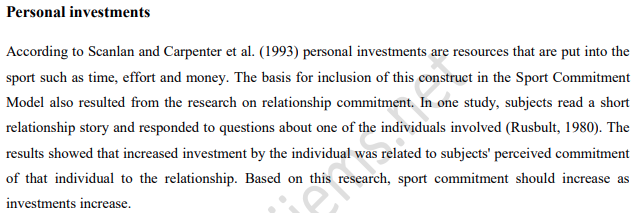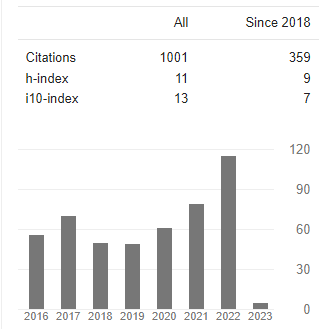The Relationship Between Sports commitment and Athlete satisfaction in sports activities: Review of Related Literature.
Abstract
The main purpose of this review of related literature is to identify the relationship between sports commitments and athlete satisfaction in sports activities. To this end, the study utilized international, national, and provincial sports activities and had them recall the amount of time they spent in individual and team practice, sport-related activities, and everyday activities at the start of their career. Furthermore, the athletes were asked to rate those activities in terms of their relevance for improving performance, effort and concentration required, and enjoyment. Since sport enjoyment and social constraint is highly related to sport commitment and athlete satisfaction. this paper identifies the relationship between sports commitments variables sport commitment (SC), sport enjoyment (SE), social constraints (SSC), and involvement opportunities with athlete satisfaction variables training and instruction satisfaction (TIS), personal treatment satisfaction (PTS), team performance satisfaction (TPS), and individual performance satisfaction (IPS). This paper concludes that the sports commitments and player satisfaction variables are positively correlated each other in sports activities. So, that to give more emphasis any concerned body for sports commitments and athlete satisfaction of their job for better improvements of the player mentally and physically and psychologically as well.
Downloads
References
Bray, S. R., Beauchamp, M.R., Eys, M. A., & Carron, A. V. (2004). Need For Clarity as a Moderator of the Role Ambiguity– Satisfaction, Relationship. Manuscript Submitted For Publication.
Chelladurai, P. (1980). Leadership in Sport Organizations. Canadian Journal of Applied Sport Sciences, 5(4), 226-231.
Chelladurai, P.(1990). Leadership in Sports: A Review. International Journal of Sport Psychology, 21, 328-354.
Chelladurai, O.,& Riemer, H.A. (1997). A Classification of Facets Of Athlete Satisfaction: Journal Of Sport Management, Vol.11, 133-159.
Chelladurai, P., & Riemer, H. (1998). Measurement of Leadership in Sports. In J. L. Duda (Ed.). Advances in Sport and Exercise Psychology Measurement 227-253.
Deeter, T. E. (1988). Does attitudinal commitment predict physical activity participation Journal of Sport Behavior, 11., 177-192.
Gill, D. L., Gross, J.B., & Huddleston, S. (1981). Participation motivation in youth sport. International Journal of Sport Psychology, fi, 160-177.
Gould, D., Feltz, D. L., & Weiss, M. (1985). Motives for participating in competitive youth swimming. International Journal of Sport Psychology, lQ, 126-140.
Gould, D., & Horn, T. (1984). Participation motivation in young athletes. In J.M. Silva, III & R. S. Weinberg (Eds.), Psychological foundations of sport (pp. 359-370).
Gould, D., & Petlichkoff, L. (1988). Participation motivation and attrition in young athletes. In F. L. Smoll, R. A. Magill, & M. J. Ash (Eds.), Children in sport (pp. 161-178). Champaign, IL: Human Kinetics.
Jackon, S.E. & Schuler, R.S. (1985). A Meta-Analysis and Conceptual Critique of Research on Role Ambiguity and Role Conflict in Work Settings. Organizational Behavior and Human Decision Processes, 36, 16-78.
Johnson, D. J., & Rusbult, C. E. (1989). Resisting temptation: Devaluation of alternative partners as a means of maintaining commitment in close relationships. Journal of Personality and Social Psychology, .52(6), 967-980.
Lerch, S. (1984). Athletic retirement as social death: An overview. In N. Theberge & P. Donnelly (Eds.), Sport and the sociological imagination (pp. 259-272). Fort Worth, Texas: Christian University Press.
LoBiondo-Wood, G., & Haber, J. (1998). Nursing research: Methods and critical appraisal for evidence-based practice. Elsevier Health Sciences.
Maday, K. M. (2000). Goal Orientation and Level of Satisfaction In Runners. Unpublished Master’s Thesis, Springfield College, Ma.
Rail (1987). Fan support of sport teams: The effect of a common group identity. Journal of Sport & Exercise Psycholo . H, 28-39.
Riemer, H.A., & Chelladurai, P. (1998). Development of the Athlete Satisfaction Questionnaire. Journal of Sport and Exercise Psychology. Vol. 20, 127-156.
Riemer, H.A., & Toon, K. (2001). Leadership and Satisfaction in Tennis: Examination of Congruence, Gender and Ability. Research Quarterly For Exercise and Sport, Vol.72, 243-256.
Rusbult, C. E. (1980).Commitment and satisfaction in romantic associations: AModeltestof. the Investment Journal of Experimental Social Psychology. 1.6, 172-186.40
Santee, R. T., & Jackson, S. E.(1979).Commitment to self-identification: A sociopsychological approach to personality. Human Relations, .32.(2), 141-158.
Scanlan, T. K., Carpenter, P. J., Schmidt, G. W., Simons, J.P., & Keeler, B. (1993), An introduction to the sport commitment model. Journal of Exercise & Sport Psychology. 12, 1-15.
Scanlan, T. K., & Lewthwaite, R. (1986). Social psychological aspects of the competitive sport experience for male youth sport participants: VI. Predictors of enjoyment. Journal of Sport Psychology, B., 25-35.
Scanlan, T. K., Simons, J. P., Carpenter, P. J., Schmidt, G. W., & Keeler, B. (1993), The sport commitment model: Measurement development for the youth sport domain. Journal of Sport & Exercise Psychology. 15. 16-38.
Scanlan, T. K & Simons, J. P. (1992).The construct of sport enjoyment. In G. C. Roberts (ed.), Motivation in sport and exercise (pp. 199-215).
Schmidt, G. W., & Stein, G. L. (1991). Sport commitment: A model integrating enjoyment, dropout, and burnout. Journal of Sport & Exercise Psychology, .8. 254-265.
Yair, G. (1990). The commitments to long distance running and levels of activity: Personal or structural? Journal of Leisure Research, 22. 213-227.















